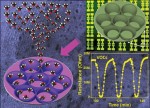In the latest issue of Analytical Methods, three articles are highlighted on the covers.
On the front cover is work from Robin Taylor and colleagues of the National Nuclear Laboratory, at various sites across the UK.
There are a number of nuclear legacy fuel storage ponds and silos in the UK that contain substantial volumes of corroding spent Magnox fuel pieces. Understanding the nature and behaviour of the radionuclides in the ponds, including any potential for activity transfer from solid to solution phases, is critical in the environmental clean-up of these nuclear legacy facilities. The results presented in this paper indicate that Pu redox chemistry, and therefore solubility, varies across the pond, which has implications for Pu behaviour during waste processing.
Characterisation of plutonium species in alkaline liquors sampled from a UK legacy nuclear fuel storage pond
Colin R. Gregson, Jeremy J. Hastings, Howard E. Sims, Helen M. Steele and Robin J. Taylor
Anal. Methods, 2011, 3, 1957-1968
DOI: 10.1039/C1AY05313B
Work from Toshihiro Fujii of Meisei University and colleagues is shown on the inside front cover.
They investigated the thermal decomposition of Japanese lacquer liquid and films by means of evolved gas analysis-ion attachment mass spectrometry. Their results indicated two stages of water release, vaporization and intramolecular H2O elimination, and the kinetics of these two processes were studied.
Characterization of Japanese lacquer liquid and films by means of evolved gas analysis-ion attachment mass spectrometry
Masamichi Tsukagoshi, Yuki Kitahara, Seiji Takahashi, Takahisa Tsugoshi and Toshihiro Fujii
Anal. Methods, 2011, 3, 1943-1947
DOI: 10.1039/C1AY05215B
On the back cover, Sherif A. El-Safty and Nguyen Duc Hoa of the National Institute for Materials Science introduce the use of highly ordered mesoporous silica/metal oxide nanocomposite monoliths for volatile organic compound gas sensor applications.
Highly sensitive and selective volatile organic compound gas sensors based on mesoporous nanocomposite monoliths
Nguyen Duc Hoa and Sherif A. El-Safty
Anal. Methods, 2011, 3, 1948-1956
DOI: 10.1039/C1AY05333G













